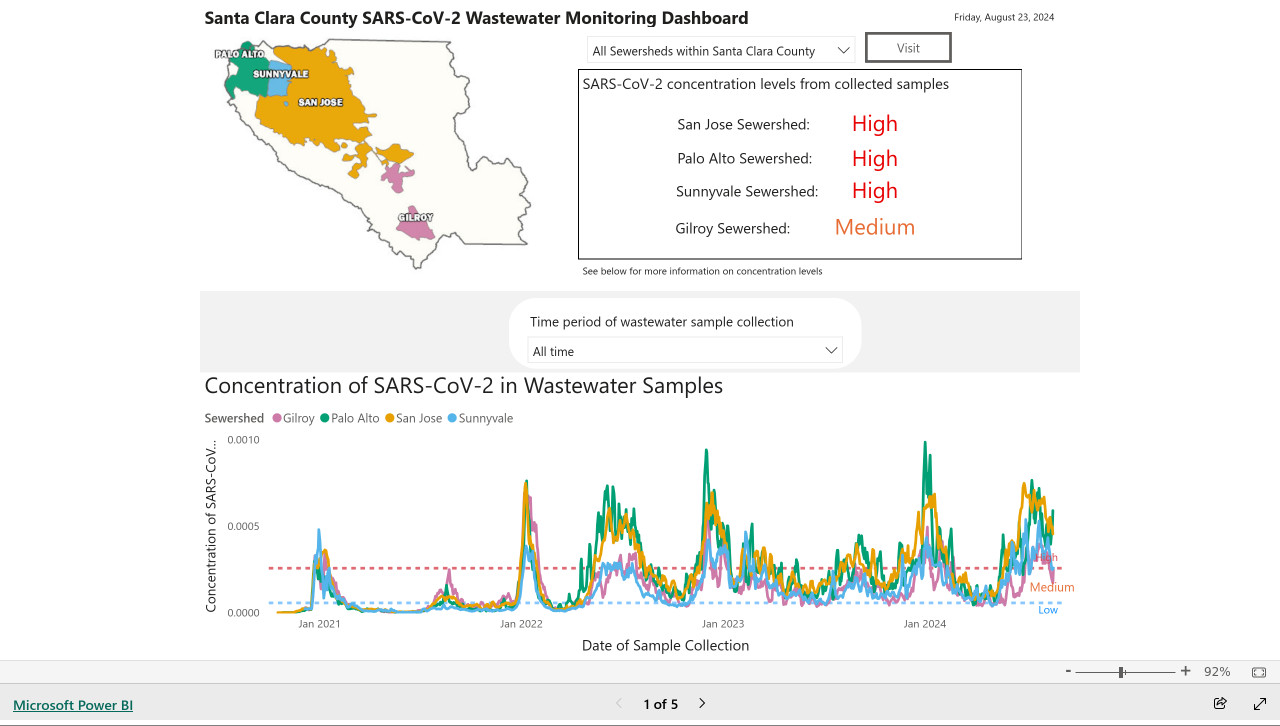Posts tagged accessibility in Aug
Filters: Month: Aug × accessibility × Sorted by date
My @covidsewage bot now includes useful alt text. I've been running a @covidsewage Mastodon bot for a while now, posting daily screenshots (taken with shot-scraper) of the Santa Clara County COVID in wastewater dashboard.
Prior to today the screenshot was accompanied by the decidedly unhelpful alt text "Screenshot of the latest Covid charts".
I finally fixed that today, closing issue #2 more than two years after I first opened it.
The screenshot is of a Microsoft Power BI dashboard. I hoped I could scrape the key information out of it using JavaScript, but the weirdness of their DOM proved insurmountable.
Instead, I'm using GPT-4o - specifically, this Python code (run using a python -c block in the GitHub Actions YAML file):
import base64, openai client = openai.OpenAI() with open('/tmp/covid.png', 'rb') as image_file: encoded_image = base64.b64encode(image_file.read()).decode('utf-8') messages = [ {'role': 'system', 'content': 'Return the concentration levels in the sewersheds - single paragraph, no markdown'}, {'role': 'user', 'content': [ {'type': 'image_url', 'image_url': { 'url': 'data:image/png;base64,' + encoded_image }} ]} ] completion = client.chat.completions.create(model='gpt-4o', messages=messages) print(completion.choices[0].message.content)
I'm base64 encoding the screenshot and sending it with this system prompt:
Return the concentration levels in the sewersheds - single paragraph, no markdown
Given this input image:

Here's the text that comes back:
The concentration levels of SARS-CoV-2 in the sewersheds from collected samples are as follows: San Jose Sewershed has a high concentration, Palo Alto Sewershed has a high concentration, Sunnyvale Sewershed has a high concentration, and Gilroy Sewershed has a medium concentration.
The full implementation can be found in the GitHub Actions workflow, which runs on a schedule at 7am Pacific time every day.
Reckoning. Alex Russell is a self-confessed Cassandra - doomed to speak truth that the wider Web industry stubbornly ignores. With this latest series of posts he is spitting fire.
The series is an "investigation into JavaScript-first frontend culture and how it broke US public services", in four parts.
In Part 2 — Object Lesson Alex profiles BenefitsCal, the California state portal for accessing SNAP food benefits (aka "food stamps"). On a 9Mbps connection, as can be expected in rural parts of California with populations most likely to need these services, the site takes 29.5 seconds to become usefully interactive, fetching more than 20MB of JavaScript (which isn't even correctly compressed) for a giant SPA that incoroprates React, Vue, the AWS JavaScript SDK, six user-agent parsing libraries and a whole lot more.
It doesn't have to be like this! GetCalFresh.org, the Code for America alternative to BenefitsCal, becomes interactive after 4 seconds. Despite not being the "official" site it has driven nearly half of all signups for California benefits.
The fundamental problem here is the Web industry's obsession with SPAs and JavaScript-first development - techniques that make sense for a tiny fraction of applications (Alex calls out document editors, chat and videoconferencing and maps, geospatial, and BI visualisations as apppropriate applications) but massively increase the cost and complexity for the vast majority of sites - especially sites primarily used on mobile and that shouldn't expect lengthy session times or multiple repeat visits.
There's so much great, quotable content in here. Don't miss out on the footnotes, like this one:
The JavaScript community's omertà regarding the consistent failure of frontend frameworks to deliver reasonable results at acceptable cost is likely to be remembered as one of the most shameful aspects of frontend's lost decade.
Had the risks been prominently signposted, dozens of teams I've worked with personally could have avoided months of painful remediation, and hundreds more sites I've traced could have avoided material revenue losses.
Too many engineering leaders have found their teams beached and unproductive for no reason other than the JavaScript community's dedication to a marketing-over-results ethos of toxic positivity.
In Part 4 — The Way Out Alex recommends the gov.uk Service Manual as a guide for building civic Web services that avoid these traps, thanks to the policy described in their Building a resilient frontend using progressive enhancement document.
You can stop using user-scalable=no and maximum-scale=1 in viewport meta tags now. Luke Plant points out that your meta viewport tag should stick to just “width=device-width, initial-scale=1” these days—the user-scalable=no and maximum-scale=1 attributes are no longer necessary, and have a negative impact on accessibility, especially for Android users.
Capital Radio’s London Guide. Worth pointing out: the search / map interface on this page is one of the best examples of progressive enhancement I’ve ever seen. Try disabling JavaScript and see what happens. It seems like most developers just can’t be bothered with this kind of attention to detail these days, which disappoints me.
This Week in HTML 5—Episode 1.
It looks like the most controversial aspect of the HTML 5 spec has been addressed - now, instead of omitting the alt attribute for user generated content that has no relevant information available, sites are advised to provide an indication of the kind of image expected surrounded by braces, for example alt="{uploaded photo}".
Why the Alt Attribute May Be Omitted. “The benefit of requiring the alt attribute to be omitted, rather than simply requiring the empty value, is that it makes a clear distinction between an image that has no alternate text (such as an iconic or graphical representation of the surrounding text) and an image that is a critical part of the content, but for which not alt text is available.”
Too much accessibility
Tom Gilder is right on target with his latest rant about sites that add accessiblity features without thinking about their consequences. Accessibility frequently involves adding new markup but you can definitely have too much of a good thing.